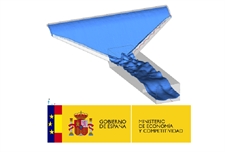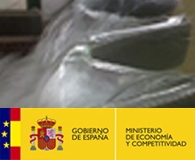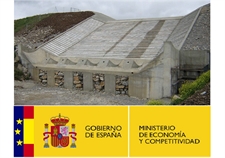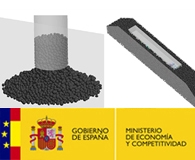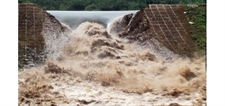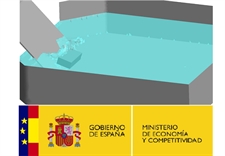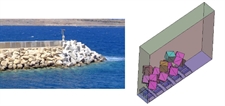POLILAB
POLILAB
DEVELOPMENT OF A LABYRINTH-SHAPED GATE IN ORDER TO INCREASE THE SPILLWAYS CAPACITY
PARTNERS: CARLOS GRANELL INGENIEROS CONSULTORES, VEMSA, CEDEX, UPM, CIMNE
The increasing demand for security of advanced societies and the hydrological extreme scenarios which could be propitiated by climate change have led to update the design criteria for dams towards more restrictive standards.
In recent years, countries such as Spain, France and Germany have adopted new legislations on dam safety, which increase the required standards for new dam spillways and those already built.
In Spain, a high portion of dams was built under the standards of the previous law (Instrucción para el diseño, Construcción y explotación de grandespresas, 1967), so their spillways have to be upgraded in order to increase their discharge capacity according the new legislation.
On another note, the shortage of cheap fossil energy resources and the growing need for renewable energy generation to comply with the UE 2020 Strategy, have led to a renewed interest in hydropower plants. The energy produced by a hydropower plant is related to the storage capacity of the associated reservoir, so augmenting the latter allows increasing the power generation without the need for dam heightening.
Therefore the development of a method to increase the spillways capacity in an easy and low cost way has relevant applications.
POLILAB project aims to develop a labyrinth or piano key-shaped gate to be installed over the existing spillways, thereby the discharge capacity will be raised and so will be the dam safety against overtopping.
The main issues to be addressed to achieve this objective are:
1) Characterisation of the influence of weir geometry, in relation with upstreamstream lines.
2) Aeration effects.
3) Coupled Hydraulic-Structural optimization of labyrinth design for different flow approach conditions.
4) Optimisation of the geometry and construction materials with the aim of ensuring durability, impact resistance and hydraulic stability.
5) Optimisation of gate recovery system.
6) Validation of the design criteria via physical and numerical testing.
CIMNE''s main contribution to the Project is the numerical testing of the proposed geometries under different hydraulic conditions. The numerical simulations are being performed with the code EdgeBsedLevelSet, developed in the KRATOS framework.


Figure 1: Numerical simulation of labyrinth weir with 1 clycle and the same flow. Left: upstream apex. Right: downstream apex.


Figure 2: Numerical simulations of labyrinth weir with 4 cycles and 2 flows.
 Este proyecto ha sido cofinanciado por el Ministerio de Economía y Competitividad, en el marco del Plan Nacional de Investigación Científica, Desarrollo e Innovación Tecnológica (2008-2011). Programa Nacional de Cooperación Público-Privada. Subprograma INNPACTO (IPT- 2012-0185-380000).
Este proyecto ha sido cofinanciado por el Ministerio de Economía y Competitividad, en el marco del Plan Nacional de Investigación Científica, Desarrollo e Innovación Tecnológica (2008-2011). Programa Nacional de Cooperación Público-Privada. Subprograma INNPACTO (IPT- 2012-0185-380000).Related items
-
09/02/2015ALCON DEVELOPMENT OF DESIGN CRITERIA TO INCREASE THE DISCHARGE CAPACITY IN GRAVITY DAMS USING SPI...
-
09/02/2015POLILAB DEVELOPMENT OF A LABYRINTH-SHAPED GATE IN ORDER TO INCREASE THE SPILLWAYS CAPACITY PAR...
-
08/09/2014ACUÑA DEVELOPMENT OF METHODOLOGY FOR THE DESIGN OF SPILLWAYS USING WEDGE-SHAPED BLOCKS OVER ...
-
30/05/2014BALAMED DEVELOPMENT OF TOOLS BASED ON THE DISCRETE ELEMENT METHOD (DEM) FOR SIMULATING THE RESPON...
-
09/04/2014eDAMS EXPERIMENTAL AND NUMERICAL METHODS FOR SAFETY ASSESSMENT AND PROTECTION OF EARTH AND ROCKFI...
-
08/02/2014XLIDE DEVELOPMENT OF TOOLS FOR ANALYTICS OF STABILITY IN SLOPES WITH HIGH POTENTIAL RISK FOR CRIT...
-
14/01/2013SEPRISIS STUDY ON DAM SAFETY AND INDENTIFICATION OF RISK SCENARIOS USING EXPERT SYSTEMS PARTNERS...
-
09/04/2012SAYOM INNOVATIVE SUPPORT SYSTEM FOR PLANNING, CONSTRUCTION AND EXPLOITATION OF MARINE WORKS PART...
-
19/12/2011Acronym: VADIVAP Reference: CIT-460000-2009-5 Title: Estudio de las principales v...



